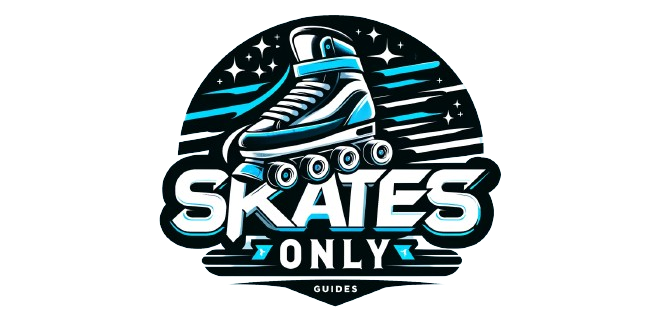Skiing poses a unique combination of challenges—control, balance and the use of specific muscle groups. Amateurs and professionals alike continually search for exercises that can improve their skills on the slopes.
One such activity is inline skating, which offers substantial benefits for budding ski enthusiasts. This comprehensive article explains “does inline skating help with skiing?”.
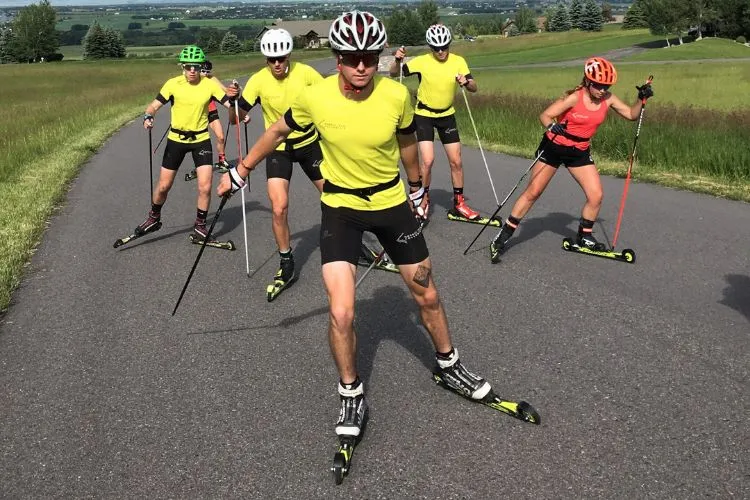
Does Inline Skating Help with Skiing?
Yes, inline skating can significantly help with skiing. Both activities use similar muscle groups and techniques. Inline skating mimics the lateral movements, balance, and coordination required in skiing, thus serving as a great off-season training exercise.
It improves your leg strength, core stability, and endurance, which are crucial for skiing. Additionally, it helps in refining carving turns, enhancing weight shifting skills, and boosting overall body control.
Therefore, regular inline skating can contribute to improved skiing performance and reduce the risk of injuries on the slopes. However, for maximum benefit, it should be combined with specific fitness and strength exercises.
Understanding the Link
At first glance, one might not find much common ground between inline skating and skiing. After all, one takes place on a pavement, the other atop snow-clad heights. However, when noticed more closely, a sophisticated ballet of balance, coordination and muscle exertion dances its way through both sports.
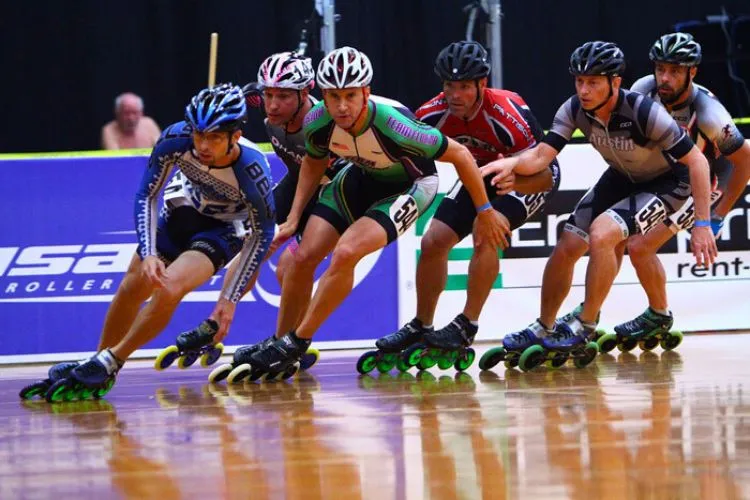
Inline skating demands rhythm and control. It presents an unpredictable variety of terrain just as skiing does, maintaining necessary caution and balance that’s crucial on the slopes. They share inherent challenges, making inline skating an excellent activity for off-season ski training.
Skills Transfer: Inline to Alpine
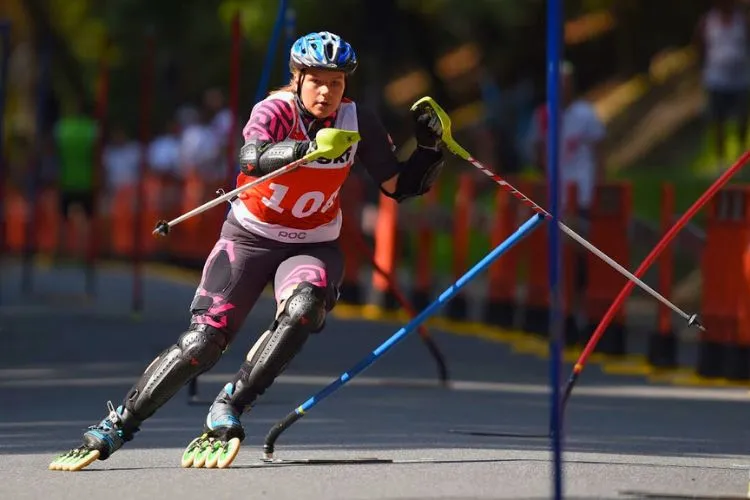
Balance and Coordination
Inline skating balances the body on thin rolling wheels, a remarkable feat that aids in honing a skater’s balance and coordination. A skier will find similar balancing requirements. As skaters master their movements, they inherently fine-tune their coordination, a boon to their skiing escapades.
Muscle Strength and Endurance
Inline skating is a physically demanding exercise, pushing various muscles into action. The key muscle groups required in skiing—quads, glutes, and core—are similarly activated during inline skating. This activation enhances muscle endurance, a deciding factor between an easy and taxing day on the slopes.
Edge Control and Carving
Inline skating also provides a solid platform to practice edge control and carving techniques. As with skiing, inline skates function best when carving, turning using the edges instead of head-on braking. This technique directly translates to efficient turning and maneuvering on skies.
From Asphalt to Snow: Bridging the Terrain Gap
The transition from skating on a pavement to skiing on snow is surprisingly smooth, except for differences in friction and temperature. The skills acquired while inline skating bear a fascinating resemblance to those needed while skiing. Seasoned skaters take this to their advantage, assuming skiing’s tell-tale body position (a crouch), optimally transferring their integrated skills onto the snow.
Real-life examples are plentiful. Many skiers have found success on the snowy slopes after seasons spent on skates. Athletes often recount their experiences, describing the switch from skating to skiing as seamless and effortless.
You may Also Find Useful: Does Inline Skating Help You Lose Weight? | Inline Skates vs Quad Skates
Training Tips for Skiers using Inline Skates
Integrating inline skating into regular training is beneficial and fun. Skiers can start by mastering their balance on skates, progressing from simple rollouts to complex maneuvers.

Practice should focus on carving and turning techniques, mimicking the edge control demanded by skiing. Regular sessions, ideally two or three per week, ensure optimal muscle conditioning and skills development.
Safety is paramount. Protective gear should be worn during all training sessions, including helmets and padding. Skates should be maintained for optimal performance.
Injury Prevention and Recovery
Inline skating stands tall among cross-training activities that assist in preventing common skiing injuries. By bolstering key muscles and adding to joint stability, it paves the way for enhanced skiing experiences with minimized risk factors.
Skiing indeed offers a thrilling experience, but it also makes considerable demands on the body, particularly on the knees and other joints. The risk of injury is inherent, be it from falls, incorrect posture, or simply the intense usage of specific muscle groups. Here, inline skating shines as a preventive measure.
The shared core mechanics between inline skating and skiing—such as balance, carving, and posture—ensure that many of the same muscles used in skiing are activated and fortified in inline skating.
This sports discipline works on the quadriceps, glutes, hamstrings, and core muscle groups—all vital for stability and control in skiing. Strengthening these muscles through inline skating can lead to sturdier ligaments and tendons.
Stronger muscles offer better joint protection, which is beneficial given skiing’s high impact on the knees. When these key muscles are conditioned properly, they are more efficient at absorbing shocks, reducing the strain that falls directly on the joints. In effect, it can lessen the likelihood of common skiing injuries such as anterior cruciate ligament (ACL) tears and knee sprains.
Cross-Training Science: Boosting Ski Performance with Skates
Cross-training with inline skates offers a multidisciplinary approach to enhancing skiing performance. The science of cross-training lies in its ability to target various aspects of fitness, leading to comprehensive athletic development.
Neuromuscular adaptations are at the forefront of this benefit. Inline skating engages the nervous system and muscles in a manner that hones reflexes and coordination. It facilitates motor learning—the body’s way of honing movement patterns—directly transferable to skiing.
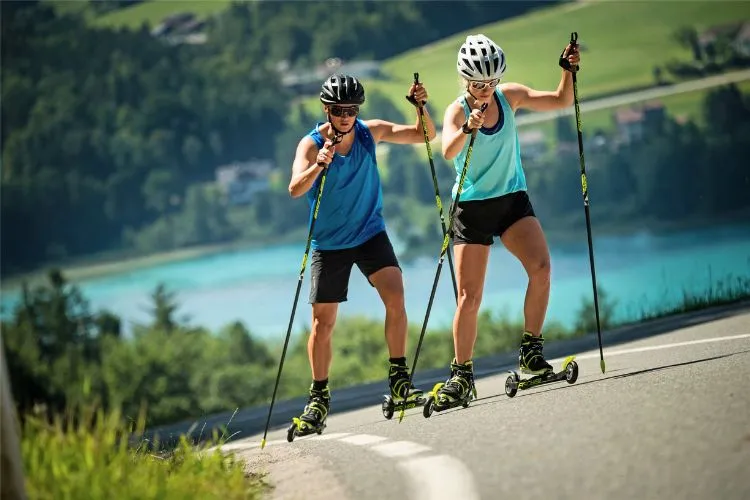
The demand for simultaneous muscle activation and relaxation improves overall neuromuscular efficiency, which can enhance the precision of ski maneuvers.
In terms of cardiovascular improvements, inline skating provides a robust aerobic workout. It boosts heart and lung function, which translates to better stamina on ski slopes. This augmented aerobic capacity ensures skiers can perform longer and recover faster. Such endurance is crucial, especially on long and demanding runs.
Finally, inline skating promotes flexibility enhancements. The dynamic movements involved, including swerving and squatting, stretch and strengthen the body’s connective tissues. This increased range of motion aids in fluid skiing movements and can help prevent injury by making joints more pliable and resilient in the face of the twists and turns typical of a ski run.
By incorporating inline skating into regular training, skiers reap the rewards of superior neuromuscular control, enhanced cardiovascular reservoirs, and improved flexibility, all of which are instrumental in elevating their performance on the snowy slopes.
Frequently Asked Questions (FAQs)
Best Inline Skates for Improving Skiing?
While personal preferences matter, skates with a brake and offering good ankle support are ideal for ski training.
How Does Inline Skating Technique Compare to Skiing?
While the terrain differs, the balance, carving techniques, and muscles used are strikingly similar.
Inline Skating Training Schedule for Ski Improvement?
Start with two to three sessions a week, focusing on balance, carving and using your core.
Nutritional Support for Skiers and Skaters
A well-balanced diet can significantly enhance the benefits of cross-training with inline skating for skiing. Proper nutrition supports muscle recovery, enhances performance, and reduces the risk of injuries. Here are some key dietary considerations:
Protein Intake: Protein is essential for muscle repair and growth. Skiers and skaters should include high-quality protein sources in their diet, such as lean meats, fish, eggs, dairy products, legumes, and nuts. Adequate protein intake helps in maintaining muscle mass and strength, crucial for both skiing and skating.
Carbohydrates: Carbohydrates are the primary energy source for high-intensity activities like skiing and inline skating. Whole grains, fruits, vegetables, and legumes provide complex carbohydrates that fuel your workouts and help sustain energy levels.
Hydration: Staying hydrated is vital for optimal performance. Water regulates body temperature, lubricates joints, and transports nutrients. Athletes should drink water regularly throughout the day and consider electrolyte-rich drinks during intense training sessions to replace lost minerals.
Healthy Fats: Healthy fats, such as those found in avocados, nuts, seeds, and olive oil, support overall health and provide a sustained energy source. Including these fats in your diet can help maintain energy levels during long training sessions.
Vitamins and Minerals: Vitamins and minerals play a crucial role in muscle function, bone health, and recovery. Ensure an adequate intake of calcium, vitamin D, magnesium, and potassium through a varied diet that includes dairy products, leafy greens, and fruits.
Pre- and Post-Workout Nutrition: Consuming a balanced meal or snack before and after workouts can optimize performance and recovery. Before training, opt for a meal rich in carbohydrates and moderate in protein. After training, focus on a combination of protein and carbohydrates to replenish glycogen stores and repair muscles.
Mental Training and Visualization
Mental training is an often-overlooked aspect of athletic performance. Visualization techniques, in particular, can be highly effective for both skiers and skaters. Here’s how mental training can complement physical training:
Visualization Techniques: Visualization involves mentally rehearsing your performance. Imagine yourself executing perfect turns, maintaining balance, and navigating challenging terrain. This mental practice can enhance muscle memory and boost confidence.
Goal Setting: Setting specific, achievable goals can motivate you to stay committed to your training regimen. Break down your long-term goals into smaller, manageable milestones, and track your progress.
Mindfulness and Focus: Practicing mindfulness can improve concentration and reduce stress. Techniques such as meditation and deep breathing exercises help athletes stay present and focused during training and competitions.
Overcoming Fear: Both skiing and inline skating can present challenging and sometimes intimidating situations. Developing mental resilience and strategies to overcome fear can enhance your overall performance and enjoyment of the sports.
Conclusion
The connection between skiing and inline skating stretches beyond their popularity as exhilarating sports activities. Similar demands of balance, coordination, and physical strength make inline skating extend beyond jus a hobby to a beneficial cross-training opportunity for skiers.
As the knowledge about this unique relation deepens, more and more skiing enthusiasts might just find themselves embracing the roller-blading lifestyle during off-seasons. Because when the goal is to conquer the snowy mountains, every bit of training counts!
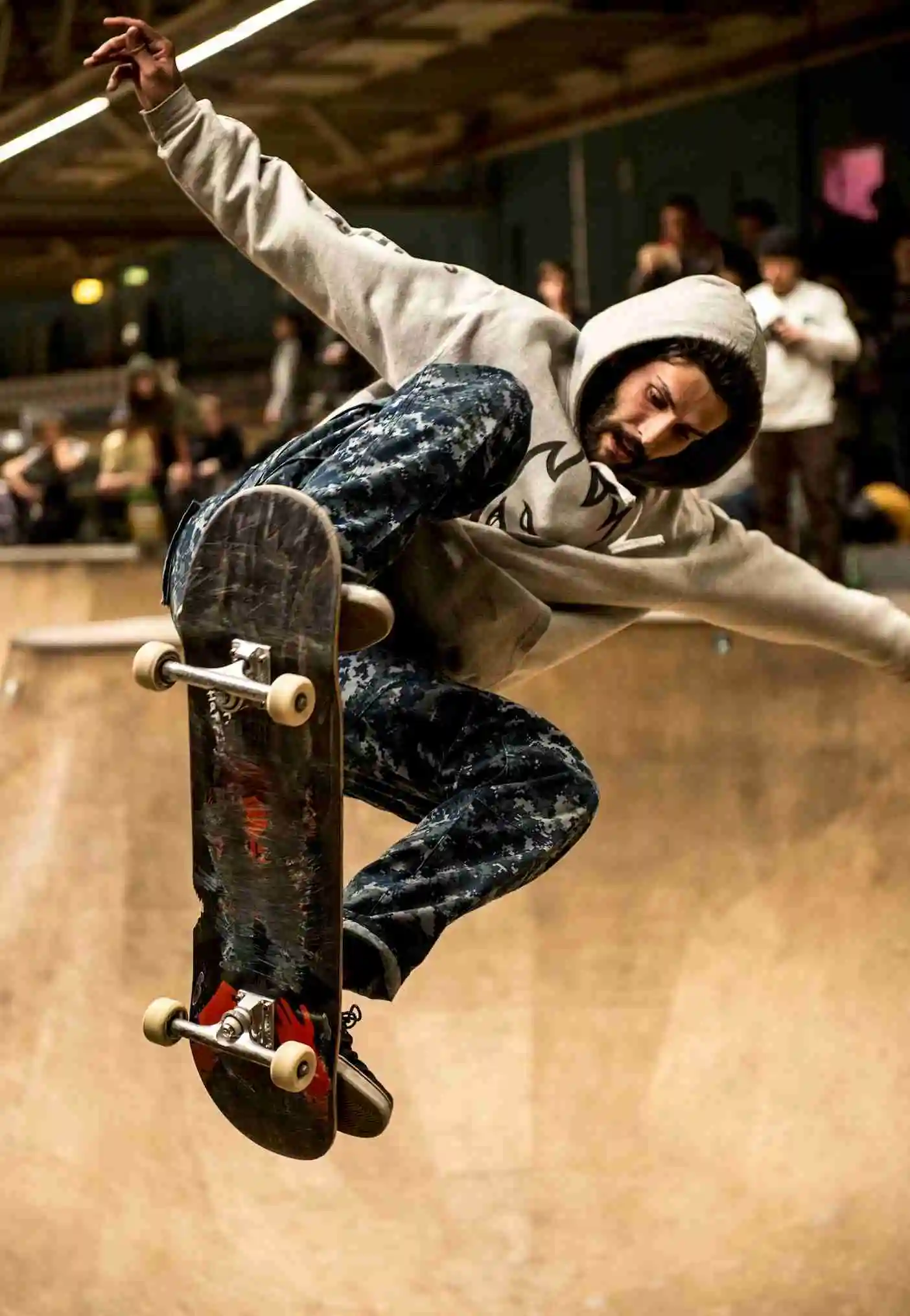
Matthew James is a passionate skater who wanted to create a platform to share his love for skating with others. With a vision to create a vibrant community of skaters, he aims to provide a space where skaters of all levels can connect, learn, and grow together.
